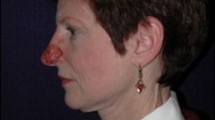Abstract
Background
Overresection of the lateral crura of the lower lateral cartilages is referred to as the most common cause of nasal valve collapse after rhinoplasty. The modern approach to functional rhinoplasty recognizes the importance of the tip framework’s structural integrity and preserves tip support.
Methods
Traditional cephalic resections of lateral crura were performed on one side of five adult cadaver noses. On the opposite sides, hinged flaps of lateral crura were created. The noses were cross-sectioned at or near the internal nasal valve level, and the difference between the two sides was described.
Results
The study findings demonstrated improvement in the postoperation nasal valve area of the hinged flap side compared with the cephalic trim side.
Conclusions
This preliminary study showed that the hinged flap is an option in nasal tip reduction surgery that may provide improved long-term aesthetic and functional outcomes through preservation of the nasal valve area.



Similar content being viewed by others
References
Adamson PA, Funk E (2009) Nasal tip dynamics. Facial Plast Surg Clin N Am 17:29–40
Adamson PA, Litner JA, Dahiya R (2006) The M-Arch model: a new concept of nasal tip dynamics. Arch Facial Plast Surg 8:16–25
Bruintjes TD, Olphen AF, Hillen B, Weijs WA (1996) Electromyography of the human nasal muscles. Eur Arch Otorhinolaryngol 253:464–469
Deroee AF, Younes AA, Friedman O (2011) External nasal valve collapse repair: the limited alar-facial stab approach. Laryngoscope 121:474–479
Kalan A, Kenyon GS, Seemungal TA (2001) Treatment of external nasal valve (alar rim) collapse with an alar strut. J Laryngol Otol 115:788–791
Kim DW, Rodriguez-Bruno K (2009) Functional rhinoplasty. Facial Plast Surg Clin N Am 17:115–131
Mlynski G, Grützenmacher S, Plontke S, Mlynski B, Lang C (2001) Correlation of nasal morphology and respiratory function. Rhinology 39:197–201
Most SP (2008) Trends in functional rhinoplasty. Arch Facial Plast Surg 10:410–413
Murakami CS, Barrera JE, Most SP (2009) Preserving structural integrity of the alar cartilage in aesthetic rhinoplasty using a cephalic turn-in flap. Arch Facial Plast Surg 11:126–128
Nigro CE, Nigro JF, Mion O, Mello JF (2009) Nasal valve: anatomy and physiology. Braz J Otorhinolaryngol 75:305–310
Sazgar AA (2010) Horizontal reduction using a cephalic hinged flap of the lateral crura: a method to treat the bulbous nasal tip. Aesthet Plast Surg 34:642–645
Sazgar AA (2010) Lateral crural setback with cephalic turn-in flap: a method to treat the drooping nose. Arch Facial Plast Surg 12:427–430
Conflicts of interest
None.
Author information
Authors and Affiliations
Corresponding author
Rights and permissions
About this article
Cite this article
Sazgar, A.A., Woodard, C. & Most, S.P. Preservation of the Nasal Valve Area With a Lateral Crural Hinged Flap: A Cadaveric Study. Aesth Plast Surg 36, 244–247 (2012). https://doi.org/10.1007/s00266-011-9797-6
Received:
Accepted:
Published:
Issue Date:
DOI: https://doi.org/10.1007/s00266-011-9797-6




